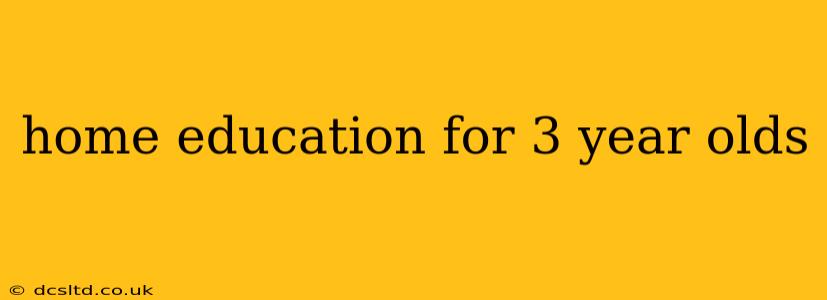Home education for 3-year-olds isn't about formal schooling; it's about nurturing curiosity and fostering a love of learning through play. This age is all about exploration, discovery, and developing fundamental skills. This guide will offer insights into creating a rich and engaging learning environment for your three-year-old at home.
What are the benefits of home education for 3-year-olds?
Home education allows you to tailor the learning experience precisely to your child's individual needs, pace, and interests. You can create a fun, stimulating environment free from the pressures of a formal classroom setting. This personalized approach can lead to increased confidence, a stronger parent-child bond, and a deeper understanding of your child's learning style. Furthermore, you can easily integrate learning into everyday routines, making education a seamless part of your child's life.
What should a 3-year-old be learning at home?
At three, the focus is on developing key skills across various domains. This isn't about rote learning; it's about building a foundation through play-based activities. Here's a glimpse:
- Language Development: Reading simple books, singing songs, having conversations, and encouraging storytelling all contribute to expanding their vocabulary and communication skills.
- Cognitive Development: Puzzles, building blocks, and shape sorters help develop problem-solving skills and spatial reasoning.
- Social-Emotional Development: Playing alongside other children, engaging in imaginative play, and learning to share and cooperate are crucial for social and emotional growth.
- Physical Development: Gross motor skills are enhanced through activities like running, jumping, and climbing, while fine motor skills are developed through drawing, coloring, and playing with small toys.
How much time should I dedicate to home education with my 3-year-old?
There's no magic number. Keep the learning engaging and age-appropriate. Short, focused sessions throughout the day are more effective than one long, overwhelming session. Aim for interactive activities that blend naturally into your daily routine. Follow your child's lead; if they're engrossed in an activity, let them continue. If they're tired or losing interest, switch gears.
What are some fun learning activities for a 3-year-old?
The best learning activities are those that are fun and engaging for your child. Here are some ideas:
- Sensory Play: Playing with sand, water, playdough, or different textured materials stimulates their senses and encourages exploration.
- Art and Crafts: Drawing, painting, coloring, and making simple crafts foster creativity and fine motor skills.
- Outdoor Play: Spending time outdoors provides opportunities for physical activity, exploration, and learning about nature.
- Pretend Play: Encouraging imaginative play through role-playing and storytelling helps develop social and emotional skills.
- Music and Movement: Singing songs, dancing, and playing musical instruments enhance rhythm, coordination, and language skills.
What are some examples of home learning resources for 3-year-olds?
Numerous resources can support your home education journey. Libraries offer a wealth of age-appropriate books. Online platforms often provide educational videos and games. Simple household items like pots, pans, and spoons can be used to create engaging sensory and imaginative play activities. Remember, the best resources are those that spark your child's curiosity and enthusiasm.
How do I know if my 3-year-old is learning effectively?
Observe your child's progress and celebrate their achievements. Look for improvements in their language skills, problem-solving abilities, social interactions, and overall confidence. If you have any concerns, consult with your pediatrician or a child development specialist. Trust your instincts; you know your child best.
Is home education for 3-year-olds better than preschool?
The "better" choice depends entirely on your individual circumstances and child's needs. Preschool offers socialization opportunities and a structured learning environment, while home education provides a personalized and flexible approach. Many parents find a blend of both to be ideal.
How can I make home education fun and engaging for my 3-year-old?
Keep it playful! Focus on activities that your child enjoys. Incorporate their interests into learning opportunities. Be patient and encouraging, and remember that learning should be a positive and enjoyable experience. Celebrate their accomplishments, no matter how small.
This guide offers a starting point. Remember, the most important aspect of home education for 3-year-olds is fostering a love of learning in a safe, supportive, and playful environment. Enjoy this special time with your child as they embark on their learning journey!
